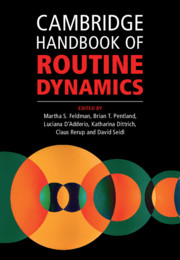Book contents
- Cambridge Handbook of Routine Dynamics
- Cambridge Handbook of Routine Dynamics
- Copyright page
- Contents
- Figures
- Tables
- Contributors
- Preface
- Chapter 1 What Is Routine Dynamics?
- Part I Theoretical Resources for Routine Dynamics Research
- Part II Methodological Issues in Routine Dynamics Research
- Chapter 8 Ethnography and Routine Dynamics
- Chapter 9 Video Methods and Routine Dynamics
- Chapter 10 Field Experiments and Routine Dynamics
- Chapter 11 Agent-Based Modelling in Routine Dynamics
- Chapter 12 Sequence Analysis in Routine Dynamics
- Chapter 13 Narrative Networks in Routine Dynamics
- Chapter 14 Bakhtin’s Chronotope and Routine Dynamics
- Part III Themes in Routine Dynamics Research
- Part IV Related Communities of Thought
- Author Index
- Subject Index
- References
Chapter 8 - Ethnography and Routine Dynamics
from Part II - Methodological Issues in Routine Dynamics Research
Published online by Cambridge University Press: 11 December 2021
- Cambridge Handbook of Routine Dynamics
- Cambridge Handbook of Routine Dynamics
- Copyright page
- Contents
- Figures
- Tables
- Contributors
- Preface
- Chapter 1 What Is Routine Dynamics?
- Part I Theoretical Resources for Routine Dynamics Research
- Part II Methodological Issues in Routine Dynamics Research
- Chapter 8 Ethnography and Routine Dynamics
- Chapter 9 Video Methods and Routine Dynamics
- Chapter 10 Field Experiments and Routine Dynamics
- Chapter 11 Agent-Based Modelling in Routine Dynamics
- Chapter 12 Sequence Analysis in Routine Dynamics
- Chapter 13 Narrative Networks in Routine Dynamics
- Chapter 14 Bakhtin’s Chronotope and Routine Dynamics
- Part III Themes in Routine Dynamics Research
- Part IV Related Communities of Thought
- Author Index
- Subject Index
- References
Summary
Organizational ethnography has been crucial for the development of the field of Routine Dynamics since the beginning. It has altered the grain size of analysis and shifted the focus from the firm and its routines to the routine and the people, actions and artefacts that bring it to life. The discovery-oriented nature of ethnographic research has and continues to challenge the conceived wisdom of routines and their role in organizations. The majority of work in Routine Dynamics relies on ethnographic approaches and sensibilities. In this chapter, I review 43 studies and the various ways in which they draw on ethnography. Despite the wide variety of settings these studies have explored and the evidentiary approaches they draw on, I argue that Routine Dynamics research can draw on more novel and innovative forms of ethnographic research. This will allow scholars to address hitherto neglected aspects of routines, such as their emotional and aesthetic qualities, new contemporary phenomena that are of societal concern, such as inequality, climate change and epidemics, and make Routine Dynamics research more practically relevant.
- Type
- Chapter
- Information
- Cambridge Handbook of Routine Dynamics , pp. 103 - 129Publisher: Cambridge University PressPrint publication year: 2021
References
- 7
- Cited by

